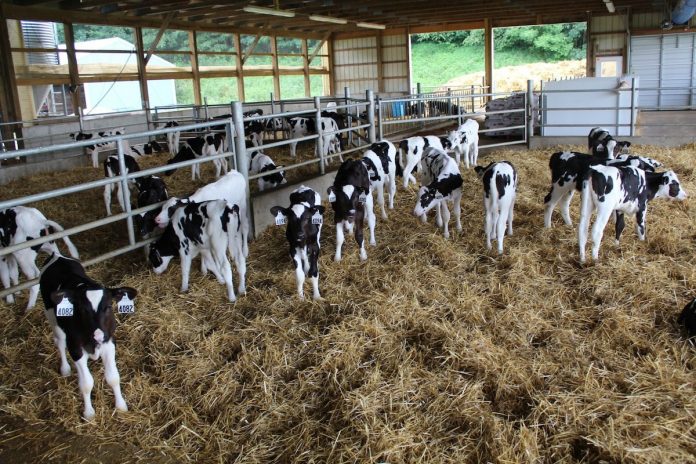The cold winds of winter have been blowing the last couple of weeks, which honestly doesn’t seem as hard to manage for calf health as the roller coaster of warm and cold weather that comes before and after. Managing calf health under either one of these weather conditions starts at hour zero of life. This is followed up with a feeding of high-quality colostrum.
Warming
Newborn calves need to be dried quickly in cool weather to allow their hair to insulate them. A calf’s temperature only must fall to 100.4 degrees Fahrenheit to begin to experience hypothermia; if it falls below 95 degrees Fahrenheit, quick warming is critical.
Calves above 95 degrees Fahrenheit with wet hair need to be warmed up using a warm room or box. Below 95 degrees Fahrenheit, calves need to be warmed up quickly using a warm water bath, then dried.
Remember that the water temperature must stay above the calf’s temperature, and the calf is basically a giant ice cube. You will need to add more warm water almost continuously. Also, the water can’t be too warm. Imagine when your fingers are cold, and you put them under warm water to wash your hands. It burns and stings.
Colostrum
Colostrum is an important source of antibodies, nutrients and energy for thermogenesis of newborn calves. Studies have shown that calves born when environmental temperatures are below 50 degrees Fahrenheit will need increased digestive heat to compensate for the heat loss that occurs especially under windy or wet conditions.
Colostrum supplies lactose, amino acids and triglycerides, which makes an excellent source of energy for heat production.
A recent study showed that calves fed colostrum at a rate of 10% or 20% of body weight had some differences in their ability to handle cold stress around birth. Higher volumes of colostrum resulted in lower respiratory rates, less shivering and a higher rectal temperature, all of which are positive for calf health.
High colostrum intake rates also resulted in a greater volume of starter consumption at four weeks old. The calves in this study were only under short-term cold stress, and no difference was found in the rate of gain or incidence of disease.
Replacements
With colostrum playing a critical role in calf thermoregulation early in life, feeding high-quality colostrum or colostrum replacements is critical. When maternal colostrum is in short supply our options are either to add colostrum supplement to low-quality colostrum or utilize colostrum replacement.
Colostrum replacer can be a great resource when you do not have maternal colostrum, or if you are experiencing issues with sick calves caused by pathogen transfer in colostrum.
Preparing teats properly is critical to colostrum management. Any manure that is stuck on the teat from the dry period must be removed before milking, or it will end up in the colostrum.
When selecting colostrum replacers or supplements, check the source of the immunoglobulins. The two options are bovine colostrum or blood serum. Both can provide immunoglobulin G to calves, but bovine colostrum is a better choice, especially in cold weather, as it also provides protein, fat and other critical nutrients that maternal colostrum provides, but blood serum, even with additives, cannot.
The biggest difference between supplements and replacements is the amount of immunoglobulin G present. Both are U.S. Department of Agriculture-regulated, with supplements providing 99 immunoglobulin G or less and replacements providing at least 100 immunoglobulin G.
Challenge
One challenge with replacements is that immunoglobulin G transfer is lower than with maternal colostrum. Studies have shown that when using colostrum replacement, the best approach is to feed within two hours of birth.
Also, pay close attention to the immunoglobulin G level in your selected colostrum replacement. To obtain a successful passive transfer, you need to feed a minimum of 200 grams of immunoglobulin G. This may mean feeding two packages of colostrum replacement. Many of these products only contain 100-150 grams of immunoglobulin G.
Investment. Colostrum supplements can be beneficial to improve low-quality colostrum, but should not be added to high-quality colostrum. Products made from bovine colostrum are superior to blood serum products.
Blood serum products have been shown to decrease passive transfer in calves fed high-quality colostrum, possibly due to a large amount of protein overwhelming areas of immunoglobulin G absorption. Also, look for a high-fat colostrum supplement to aid in cold weather energy. Maintaining a high-quality colostrum program is a worthy investment in the future of your herd.













